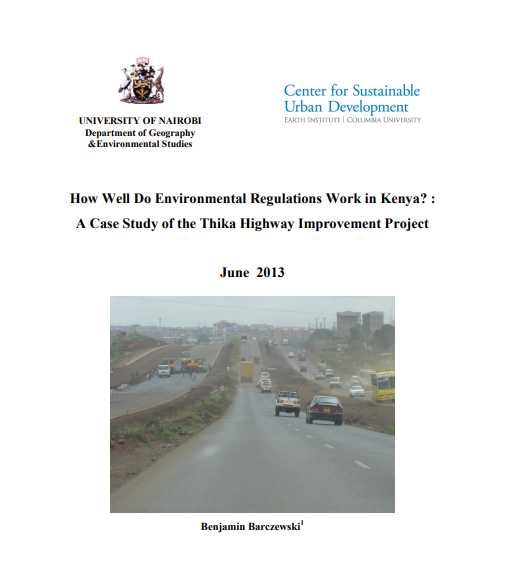Resource information
Kenya’s hurried pursuit of infrastructure developments in the last decade has highlighted the need for effective environmental regulation surrounding the approval, construction and operation of new projects. One such project, the Nairobi-Thika Highway Improvement Project (NTHIP), creates fertile ground for investigation into how well Kenya’s environmental safeguards work. Transforming the road from Nairobi to Thika town into a super highway is one of Kenya’s first large-scale transportation infrastructure projects. Funded by loans from the African Development Bank and the Chinese government, the project began in November 2010 and was completed in November 2012 although the contractors are still liable for another year if problems arise on the highway. Based on study of the NTHIP process and documents relating to environmental protection, interviews with Kenyan experts in environmental impact assessments, and a review of the current environmental legislation, this report reveals that Kenya’s current system of environmental regulation is lacking in a number of key areas. While the country’s legislation is fairly comprehensive, creating regulations designed to protect all of the varying ecosystems and covering important sectors like environmental impact assessments and waste, implementation faces a number of very serious problems. The National Environmental Management Authority (NEMA) has primary responsibility for implementing environmental safeguards in Kenya, although many actors have responsibilities including civil society, private consulting firms, development banks which finance infrastructure and other government actors including local government and the court system. Currently, the system suffers from inadequate funding, corruption, a lack of engagement with important community stakeholders, gaps or duplications of regulations, and a misunderstanding by society at-large of the benefits of a sustainable project. These serious issues result in little oversight of development projects with potentially huge environmental impacts. This work illustrates the need for a different approach to development, an approach that recognizes the real costs of doing business at the expense of the environment, and also recognizes the benefits of implementing proper environmental safeguards. More specifically, this work highlights some of the ways by which Kenyan citizens and institutions can begin to remedy some of the weaknesses in regulation through, among other things, newly created legal avenues and heightened community involvement.

